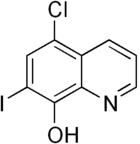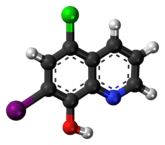Clioquinol
 | |
 | |
| Clinical data | |
|---|---|
| Trade names | Cortin |
| AHFS/Drugs.com | Micromedex Detailed Consumer Information |
| MedlinePlus | a682367 |
| Pregnancy category | |
| Routes of administration | topical only |
| ATC code |
D08AH30 (WHO) D09AA10 (WHO) (dressing) G01AC02 (WHO) P01AA02 (WHO) S02AA05 (WHO) |
| Legal status | |
| Legal status | |
| Identifiers | |
| |
| CAS Number |
130-26-7 |
| PubChem (CID) | 2788 |
| DrugBank |
DB04815 |
| ChemSpider |
2686 |
| UNII |
7BHQ856EJ5 |
| KEGG |
D03538 |
| ChEBI |
CHEBI:74460 |
| ChEMBL |
CHEMBL497 |
| ECHA InfoCard | 100.004.533 |
| Chemical and physical data | |
| Formula | C9H5ClINO |
| Molar mass | 305.50 g·mol−1 |
| 3D model (Jmol) | Interactive image |
| |
| |
| | |
Clioquinol (iodochlorhydroxyquin) is an antifungal drug and antiprotozoal drug. It is neurotoxic in large doses. It is a member of a family of drugs called hydroxyquinolines which inhibit certain enzymes related to DNA replication. The drugs have been found to have activity against both viral and protozoal infections.[2]
Antiprotozoal use
A 1964 report described the use of Clioquinol in both the treatment and prevention of shigella infection and Entamoeba histolytica infection in institutionalized individuals at Sonoma State Hospital in California. The report indicates 4000 individuals were treated over a 4-year period with few side effects.[3]
Several recently reported journal articles describing its use as an antiprotozoal include:
- A 2005 reference to its use in treating a Dutch family for Entamoeba histolytica infection.[4]
- A 2004 reference to its use in the Netherlands in the treatment of Dientamoeba fragilis infection.[5]
- A 1979 reference to the use in Zaire in the treatment of Entamoeba histolytica infection.[6]
Subacute myelo-optic neuropathy
Clioquinol's use as an antiprotozoal drug has been restricted or discontinued in some countries due to an event in Japan where over 10,000 people developed subacute myelo-optic neuropathy (SMON) between 1957 and 1970. The drug was used widely in many countries before and after the SMON event without similar reports.[7] As yet, no explanation exists as to why it produced this reaction, and some researchers have questioned whether clioquinol was the causative agent in the disease, noting that the drug had been used for 20 years prior to the epidemic without incident, and that the SMON cases began to reduce in number prior to the discontinuation of the drug.[8] Theories suggested have included improper dosing, the permitted use of the drug for extended periods of time,[9] and dosing which did not consider the smaller average stature of Japanese; however a dose dependant relationship between SMON development and clioquinol use was never found, suggesting the interaction of another compound. Researchers have also suggested the SMON epidemic could have been due to a viral infection with an Inoue-Melnick virus.[10]
Topical use
Clioquinol is a constituent of the prescription medicine Vioform, which is a topical antifungal treatment. It is also used in the form of a cream (and in combination with betamethasone) in the treatment of inflammatory skin disorders.
Use in neurodegenerative diseases
Research at UCSF indicates that clioquinol appears to block the genetic action of Huntington's disease in mice and in cell culture.[11]
Evidence from phase 2 clinical trials suggested that clioquinol could halt cognitive decline in Alzheimer's disease, possibly owing to its ability to act as a chelator for copper and zinc ions. This led to development of analogs including PBT2 as potential therapeutic compounds for the treatment of Alzheimer's disease.[12]
Recent animal studies have shown that clioquinol can reverse the progression of Alzheimer's, Parkinson's and Huntington's diseases. According to Dr. Siegfried Hekimi and colleagues at McGill's Department of Biology, clioquinol acts directly on a protein called Clk-1, often informally called “clock-1,” and might slow down the aging process. They theorize that this may explain the apparent ability of the drug to be effective in the above conditions, but warn against individuals experimenting with this drug.[13]
Continued use and manufacture around the world
| Country | Comments |
|---|---|
| United States | In August 2004, Prana Biotechnology, an Australian company and P.N Gerolymatos S.A (PNG) agreed to recognize each other's rights to market clioquinol in their respective territories, with PNG holding right for European territories, and Prana holding rights for US and Japan. |
| Canada | In 2001, the Canadian company Paladin Labs bought the rights to market Vioform from Novartis. Vioform is licensed for use in Canada as a topical anti-fungal. |
| Netherlands | 2004 and 2005 reports describe use in treatment of Dientamoeba fragilis and Entamoeba histolytica infection.[5] |
| India | Manufactured by Vishal Laboratories and LASA Laboratory[14] |
| Colombia | Manufactured by "Altea Farmacéutica C.A." for "Scandinavia Pharma"[15] |
See also
- PBT2, a related 8-hydroxyquinoline
References
- ↑ "Clioquinol topical medical facts from Drugs.com". drugs.com. Drugs.com. Retrieved 15 May 2015.
- ↑ Rohde W, Mikelens P, Jackson J, Blackman J, Whitcher J, Levinson W (1976). "Hydroxyquinolines inhibit ribonucleic acid-dependent deoxyribonucleic acid polymerase and inactivate Rous sarcoma virus and herpes simplex virus". Antimicrob. Agents Chemother. 10 (2): 234–40. doi:10.1128/aac.10.2.234. PMC 429727
 . PMID 185949.
. PMID 185949. - ↑ GHOLZ LM, ARONS WL (1964). "Prophylaxis And Therapy Of Amebiasis And Shigellosis With Iodochlorhydroxyquin". Am. J. Trop. Med. Hyg. 13: 396–401. PMID 14162901.
- ↑ Kager PA (2005). "[Outbreak of amoebiasis in a Dutch family; tropics unexpectedly nearby]". Nederlands tijdschrift voor geneeskunde (in Dutch and Flemish). 149 (1): 51–2; author reply 52–3. PMID 15651505.
- 1 2 Bosman DK, Benninga MA, van de Berg P, Kooijman GC, van Gool T (2004). "[Dientamoeba fragilis: possibly an important cause of persistent abdominal pain in children]". Nederlands tijdschrift voor geneeskunde (in Dutch and Flemish). 148 (12): 575–9. PMID 15074181.
- ↑ Masters DK, Hopkins AD (1979). "Therapeutic trial of four amoebicide regimes in rural Zaire". The Journal of tropical medicine and hygiene. 82 (5): 99–101. PMID 226725.
- ↑ Wadia NH (1984). "SMON as seen from Bombay". Acta Neurol. Scand. Suppl. 100: 159–64. PMID 6091394.
- ↑ Meade TW (1975). "Subacute myelo-optic neuropathy and clioquinol. An epidemiological case-history for diagnosis". British journal of preventive & social medicine. 29 (3): 157–69. doi:10.1136/jech.29.3.157. PMC 478909
 . PMID 127638.
. PMID 127638. - ↑ Takasu T (2003). "[SMON--a model of the iatrogenic disease]". Rinsho Shinkeigaku (in Japanese). 43 (11): 866–9. PMID 15152488.
- ↑ Ito M, Nishibe Y, Inoue YK (1998). "Isolation of Inoue-Melnick virus from cerebrospinal fluid of patients with epidemic neuropathy in Cuba". Arch. Pathol. Lab. Med. 122 (6): 520–2. PMID 9625419.
- ↑ Nguyen T, Hamby A, Massa SM (2005). "Clioquinol down-regulates mutant huntingtin expression in vitro and mitigates pathology in a Huntington's disease mouse model". Proc. Natl. Acad. Sci. U.S.A. 102 (33): 11840–5. doi:10.1073/pnas.0502177102. PMC 1187967
 . PMID 16087879.
. PMID 16087879. - ↑ Rapid restoration of cognition in Alzheimer's transgenic mice with 8-hydroxy quinoline analogs is associated with decreased interstitial Abeta.
- ↑
- ↑ Herlekar, Omkar. "Clioquinol manufacturers India". Lasa labs. Retrieved 12 March 2013.
- ↑ "Dermosupril C 0,1% desonide + 3% clioquinol for topical use" (PDF). Medihealth laboratories. Retrieved 19 September 2016.